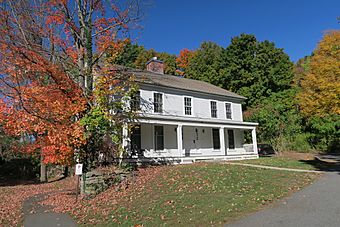Cushman Village Historic District facts for kids
Quick facts for kids |
|
|
Cushman Village Historic District
|
|

Keet House
|
|
| Location | Amherst, Massachusetts |
|---|---|
| Area | 86 acres (35 ha) |
| Architectural style | Greek Revival, Gothic, Georgian |
| NRHP reference No. | 92001553 |
| Added to NRHP | November 5, 1992 |
The Cushman Village Historic District is a special area in Amherst, Massachusetts. It's like a time capsule that shows what a busy mill village was like in the 1800s. This historic district is mainly found around Bridge, Henry, and Pine Streets in northeastern Amherst.
The village grew here because of the Mill River. The river had "falls" (small waterfalls) that could power machines. People started using this water power for mills as early as the mid-1700s. Even today, two houses from that very old colonial time are still standing!
Most of the houses in the district were built before 1860. This was when the village's factories were busiest. While the village was once full of mills, especially wooden ones, none of those industrial buildings are left. They were either torn down or destroyed by fire. In 1992, this important area was added to the National Register of Historic Places.
Contents
Discovering Cushman Village's Past
Cushman Village is in the northeastern part of Amherst. This area is where the flat lands near the Connecticut River start to become hills. The Mill River flows west near the village. It then turns south and eventually joins the Connecticut River.
How Water Power Shaped the Village
In 1738, a man named Nathaniel Kellogg got permission to use the river's water. He built a grist mill (a mill for grinding grain into flour) at the "great falls" of the Mill River. Later, in 1746, he built a lumber mill a bit further downstream. By the late 1700s, there were at least six different types of mills working on the river. Workers who worked at these mills lived in groups of houses nearby. The oldest house still standing was built before 1759. You can find it at 24 Leverett Road.
The Rise of Textile Mills
Small textile mills (factories that make cloth) were built along the river in the early 1800s. Many of these early mills were later destroyed by fire or replaced by newer buildings. When the railroad arrived and a train station was built, it helped the growing village become a central place.
Between about 1835 and 1930, mills owned by the Cushman brothers became very important. They really shaped the local economy. Most of the village's homes were built during the mid-1800s. The Cushman family owned many of these houses by the 1870s, even if they didn't build them all.
Architectural Styles in the Village
The houses in Cushman Village often had simple designs. Many were built in the Greek Revival style. This style remained popular even into the 1880s. At the same time, simpler versions of other styles were also built. These included Italianate, Second Empire, and Queen Anne Victorian homes. The house at 131 Bridge Street is a great example of a mill owner's home. It shows off some of the more detailed Greek Revival designs in the village.
Images for kids




